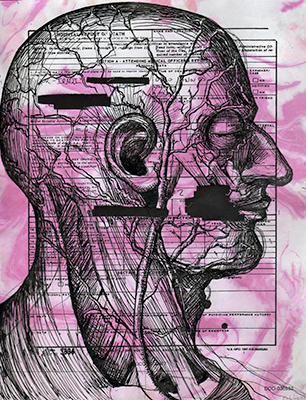Rajkamal Kahlon’s paintings, collages, and installations are surgical in nature, opening up the very bodily presence of colonial histories. The first thing we recognize in the paintings in the series Did You Kiss the Dead Body are European anatomical illustrations drawn with ink on paper. They are educational illustrations, but they may also make us think of the “ecstatic” medieval tortures of punishment. At first sight, the innocent beauty of the red and pink patterns of the paper obliterates any association with violence and bodily disintegration. The technique of marbling has its origins in Iraq and Turkey, and it is used here as a way to refer to the living interior of the body. But upon a second look, we come to recognize that behind those drawings there is text, documents. These documents are autopsy reports and death certificates from US military bases and prisons in Iraq and Afghanistan, which were controversially made public on the American Civil Liberties Union’s website in 2004 under the Freedom of Information Act. The texts highlight relations of abuse and power through descriptions of anonymous Iraqi and Afghan male prisoners, young and old, who died in US custody. The reports employ a rational scientific language to catalogue the internal and external details of the men’s bodies while attempting to determine a cause of death, ranging from “natural” to “undetermined” to “suicide.” The title of the work—Did you Kiss the Dead Body?—is a reference to the last line of Harold Pinter’s poem “Death,” read by Pinter during his 2005 Nobel Prize acceptance speech, a speech marked by sharp criticism of American foreign policy and reflections on the nature of truth, language, and power.
A new work by Rajkamal Kahlon is a large wall painting with a sculptural component. The tree, a symbol of the cycles of nature and life, here bears fruit in the form of disintegrated human fingers. The finger is the instrument of pointing, and the tree figured by Kahlon here may be read as a delirious, dream-like vision, through which the gestural “meaning” of dismembered bodies make its claims on the present.
Rajkamal Kahlon, born 1974 in USA, lives and works in Berlin

